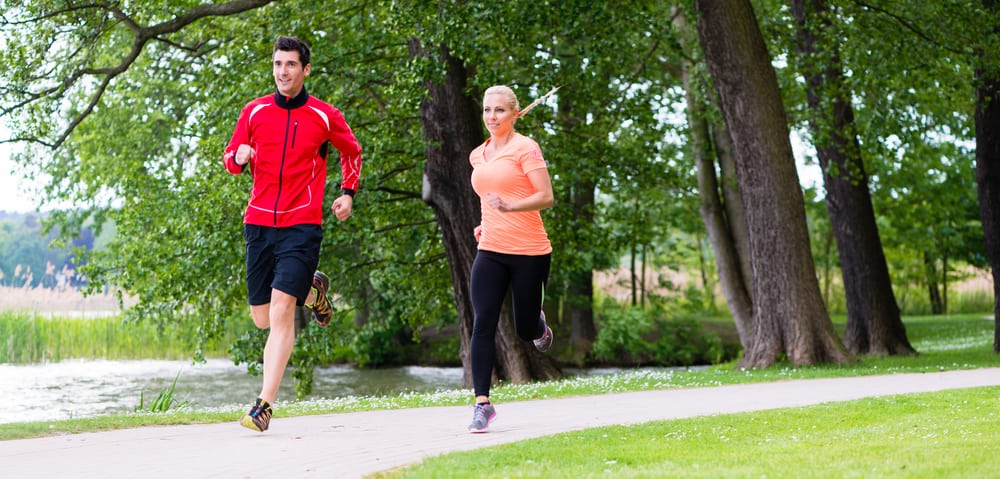“Go fast enough to get there, but slow enough to see.” — Jimmy Buffet
How many calories does a 30 minute jog burn
Jogging is the type of running that most people can easily do. Whether you’re looking for some extra fitness, mental health, physical maintenance, or weight loss; jogging is your way to go.
The amount of burned calories is our spotlight topic this time. Our question today is: How many calories does a 30 minute jog burn?
A 30-minute jog burns anywhere between 223 to 400 calories. Many factors could result in more burned calories like increased running pace, weight, and incline.
Your jog is different from his jog and different from her jog. To have a more accurate representation of how many calories a 30 minute jog burns, we need to understand the difference between different jogs.
We also need to understand the factors that affect the number of burned calories.

How Fast Is Jogging?
Jogging, also known as slow running, is going at a pace that ranges between 5 – 6 mph. Ideally, that pace should allow you to have a conversation with someone without losing breath.
To have an idea of how fast (or slow) that pace is, we’ll use walking as a comparative reference. The average walking pace among people is 3 mph.
You could be able to hold a conversation while running at even faster speeds, say 6.5 mph, for example. On the other hand, your running partner could hardly keep his breath with only a 5 mph pace.
That being said, the usual jogging pace (5 – 6 mph) isn’t rocket science. It’s the estimate among many people. What a runner considers a jogging pace could be a fast pace to another runner, and vice versa.
Some factors affect why jogging paces are different among people. The same factors also explain why some people burn more calories than others even if they run the same distance.
What Affects the Number of Burned Calories?
Here’s why the number of burned calories differs from person to person.
1. Pace
We’ve just mentioned that the jogging pace ranges between 5 to 6 mph. This may not seem like much but it creates a considerable difference the more you run.
For example, if you jog at a 5 mph pace, you will run 2.5 miles in a 30-minute jog. On the other hand, jogging at a 5.4 mph, which is only a 0.4 mph difference, will make you run 2.7 miles. That’s around 0.2 miles or 322 meters added to the same 30-minute jog.
Every slight but steady increase in your jogging pace will give you more meters at the end of the jog. This ultimately means more calories burned.
2. Weight
Weight is one of the most determining factors of how many calories you burn while you jog. Jogging is a great weight loss workout and the more weight you have, the more calories you will burn.
That applies even if you run at exactly the same pace and time as your running partner who is less heavy than you. Let’s have an example.
A runner who weighs 182 pounds will burn an estimated 288 calories with a 30-minute jog run. A runner who is only 18 pounds heavier (200 pounds) will burn 317 calories with the same pace and distance.
These results are estimated. Unless you are hooked up to sophisticated laboratory equipment, the number of calories you burn as you run will never have pinpoint accuracy. Still, it’s accurate enough to be used as a reliable reference.
You could always use a calorie calculator to see how many calories you will burn in a 30-minute jog. Just input your weight and your running time and you should get a good estimate.
3. Running Environment
The surface you run on also has an effect on how calories you burn. Some surfaces are harder (or easier) to run on than others.
Harder surfaces like asphalt roads, sandy tracks, and sidewalks usually require more energy from the body to run on. In contrast, treadmills and running tracks are often easier for our legs to run on.
Since there’s no device that can follow the surfaces you run on, it’s hard to have a calorie calculator that accurately estimates how many calories you burn.
4. Incline
Going uphill or downhill has a considerable effect on how many calories your jog will burn. The more uphill you run, the more muscle power you’ll need and the more calories you’ll burn.
An inclined treadmill will be able to tell you how many calories you burn based on the degree of inclination. Calculating these extra burned calories is much harder to do when you run outdoors.

Can You Burn More Calories in a 30 Minute Jog?
If you want to burn more calories out of your jog, there are various ways to do so.
1. Run in a Sunny Weather
Running in warm weather will induce more sweat secretion from your body.
The extra fat or triglycerides gets stored in adipose tissue all over your body. When you exercise, your body will start burning some of that extra fat and form byproducts. These byproducts leave your body through your sweat or your exhaled air.
Warm weather induces more sweat and more fat metabolism which in turn, increases the number of burned calories.
2. Go Uphill More Often
Going uphill (whether outdoors or on a treadmill) is a fantastic addition to your jog.
Not only you’d burn more calories with it, but you’ll also improve the strength of your leg muscles, especially the calves.
Running uphill forces your muscles to exert some extra effort to push your body to that inclined position. That extra gravity pull induces more metabolism in your body and thus, more calories burned.
3. Run Outdoors
Treadmills are always great but running outdoors is the essence of running. The constant change in the texture, incline, and hardness of the running surface goes a long way in increasing the number of calories burned.
Try it for yourself. Use a treadmill to jog for 15 minutes using a 5 mph pace. To avoid any bias, let your body completely rest or wait until the next day, then jog for another 15 minutes outdoors. Try to avoid any inclinations as much as you can to keep things fair.
You’ll notice how your leg muscles are slightly more worked out from the outdoor run. This becomes even more apparent in longer jogs.
The reason is that treadmills take a lot of strain out of your calves through their constant movement. Your muscles will need less effort to produce the running motion on a treadmill.
4. Run Slightly Faster
You’re not restricted to that 5 – 6 mph pace. If you feel that you can have a slightly faster pace than 6 mph and still consider it a jog, there’s no reason for you to not do that.
Since the time of running (30 minutes) is the same, you could run a little faster to make the most out of that half-hour.
Remember, as long as you can hold a conversation without losing breath, you can still call it a jog.

How Often Should You Jog?
According to the U.S. Department of Health and Human Services (HHS), healthy adults should get 150 – 300 minutes of moderate physical activity every week.
If you jog 30 minutes a day 5 times a week, you’d hit the minimum requirement of 150 minutes.
You may run an extra day of the week to push that number to 180 minutes. You could also add 10 minutes to each jog on those 5 days to reach 200 minutes of physical activity.
If you want to reach that 300-minute mark while still having the weekend for yourself, you should jog for 60 minutes 5 days a week, or jog for 50 minutes 6 days a week. Both should comfortably get you to the 300-minute mark.
Final Thoughts On How Many Calories Does a 30 Minute Jog Burn
To recap, how many calories does a 30 minute jog burn? Around 223 to 400 calories. If you are heavier or your pace is faster, you have the chance of burning more than 400 calories.
Running outdoors and uphill also contributes to more calories burned. If you regularly jog, you won’t just burn some extra calories, you’ll also keep a good degree of fitness.
The point is to keep running. Every little bit helps.

